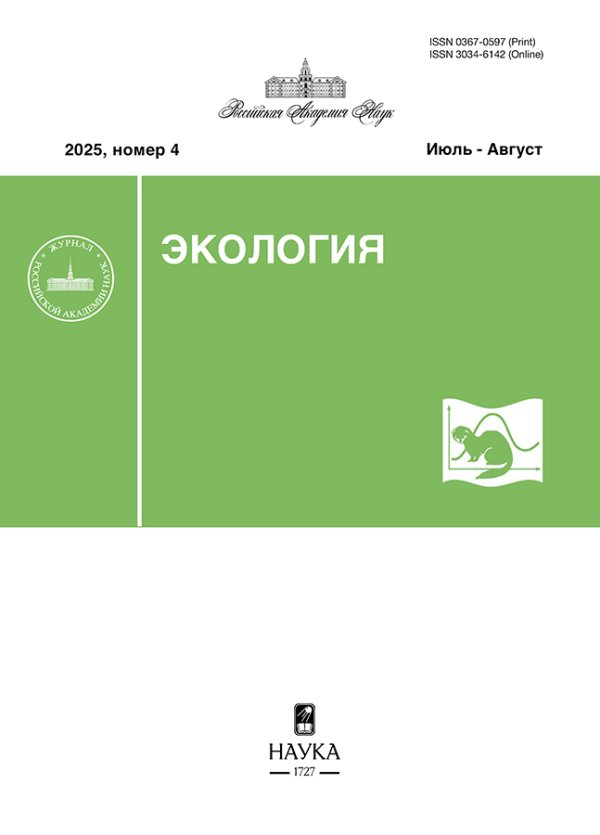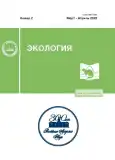Оценка долговременной динамики орнитофауны севера Западной Сибири
- Авторы: Головатин М.Г.1
-
Учреждения:
- Институт экологии растений и животных УрО РАН
- Выпуск: № 2 (2023)
- Страницы: 112-120
- Раздел: Статьи
- URL: https://journals.rcsi.science/0367-0597/article/view/139172
- DOI: https://doi.org/10.31857/S0367059723020051
- EDN: https://elibrary.ru/MXNGIY
- ID: 139172
Цитировать
Полный текст
Аннотация
Проанализированы изменения орнитофауны трех крупных областей севера ЯНАО: Нижнее Приобье, пойма Нижней Оби и п-ов Ямал, за период более 60 лет. Анализ основан на относительных оценках численности видов по 4-балльной шкале, учитывали также случаи существенного сдвига ареалов. Показано, что орнитофауны в долговременном аспекте – высоко динамичные образования, процесс изменений носит перманентный характер. Масштаб его – около половины видового состава в течение 60 лет, а их направленность различна в разных районах и зависит от степени антропогенного преобразования территории. В районах с относительно низким антропогенным воздействием (Нижнее Приобье и пойма Оби) преобладали положительные тенденции, преимущественно выраженные в появлении новых видов. Особенно много их (более 25% современного видового состава) было в пойме Оби, что указывает на канализированность процесса проникновения новых видов на север. На п-ве Ямал, где велико антропогенное воздействие, связанное с перевыпасом домашних северных оленей, преобладают отрицательные тенденции в виде сокращения численности типичных тундровых видов.
Ключевые слова
Об авторах
М. Г. Головатин
Институт экологии растений и животных УрО РАН
Автор, ответственный за переписку.
Email: golovatin@ipae.uran.ru
Россия, 620144, Екатеринбург, ул. 8 Марта, 202
Список литературы
- Кумари Э.В. Динамика орнитофауны Прибалтики за последние столетия и вероятные направления ее дальнейших изменений // Вопросы экологии: Мат-лы 3-й экологич. конф. Киев, 1957. Ч. 2. С. 277–284.
- Формозов А.Н. О движении и колебании границ распространения млекопитающих и птиц // География населения наземных животных и методы его изучения. М.: Изд-во АН СССР, 1959. С. 172–194.
- Исаков Ю.А. Состояние изученности авифауны СССР // Птицы СССР. История изучения. Гагары, поганки, трубконосые / Отв. ред. Ильичев В.Д., Флинт В.Е. М.: Наука, 1982. С. 208–227.
- Рябицев В.К. Авифаунистические исследования на Урале, в Приуралье и Западной Сибири за последнюю четверть века и взгляд на будущее // Материалы к распространению птиц на Урале, в Приуралье и Западной Сибири. Екатеринбург: Изд-во “Екатеринбург”, 2001. С. 4–12.
- Данилов Н.Н. Птицы Нижней Оби и изменения в их распространении за последние десятилетия // Экология позвоночных животных Крайнего Севера / Тр. Ин-та биол. УФАН СССР. Свердловск, 1965. Вып. 38. С. 103–109.
- Кучерук В.В., Ковалевский Ю.В., Сурбанос А.Г. Изменения населения и фауны птиц Южного Ямала за последние 100 лет // Бюлл. МОИП. Отд. биол. 1975. Т. 80. № 1. С. 52–64.
- Данилов Н.Н., Рыжановский В.Н., Рябицев В.К. Птицы Ямала. М.: Наука, 1984. 334 с.
- Калякин В.Н. Птицы Южного Ямала и Полярного Зауралья // Материалы к распространению птиц на Урале, в Приуралье и Западной Сибири. Екатеринбург: Изд-во Урал. ун-та, 1998. C. 94–116.
- Головатин М.Г. Птицы бассейна реки Войкар // Материалы к распространению птиц на Урале, в Приуралье и Западной Сибири. Екатеринбург: Изд-во “Екатеринбург”, 1999. С. 75–82.
- Головатин М.Г., Пасхальный С.П. Орнитофауна поймы Нижней Оби // Научный вестник. Вып. 4: Материалы к познанию фауны и флоры Ямало-Ненецкого автономного округа. Салехард, 2000. Ч. 1. С. 18–37.
- Рябицев В.К., Рыжановский В.Н. Птицы полуострова Ямал и Приобской лесотундры. М.; Екатеринбург: Кабинетный ученый, 2022. Т. 1: Неворобьиные. 624 с. Т. 2: Воробьинообразные. 392 с.
- Рыжановский В.Н., Пасхальный С.П. Динамика населения птиц Нижнего Приобья в связи с глобальным потеплением климата // Научный вестник. 2007. Вып. 6 (50). Ч. 2. С. 58–74.
- Golovatin M.G., Morozova L.M., Ektova S.N. et al. The change of tundra biota at Yamal peninsula (the North of the Western Siberia, Russia) in connection with anthropogenic and climatic shifts // Tundras: Vegetation, Wildlife and Climate trends. Eds. Gutierrez B., Pena C. New York: Nova Sci. Publ., 2010. Cht. 1. P. 1–46.
- Головатин М.Г. Современные аспекты динамики орнитофауны севера Западной Сибири // Наземные и морские экосистемы / Ред. совет: Бедрицкий А.И. и др. М.: Paulsen, 2011. С. 365–378.
- Smith P.A., McKinnon L., Meltofte H. et al. Status and trends of tundra birds across the circumpolar Arctic // Ambio. 2020. V. 49. P. 732–748. https://doi.org/10.1007/s13280-019-01308-5
- Коблик Е.А., Редькин Я.А., Архипов В.Ю. Список птиц Российской Федерации. М.: Тов-во научн. изд. КМК, 2006. 256 с.
- Колбовский Е.Ю., Климанова О.А. Геоинформационное картографирование сухопутных границ полуостровов (на примере полуостровов Ямал и Гыданский) // Геодезия и картография. 2018. Т. 79. № 11. С. 34–46. https://doi.org/10.22389/0016-7126-2018-941-11-34-46
- Песенко Ю.А. Принципы и методы количественного анализа в фаунистических исследованиях. М.: Наука, 1982. 287 с.
- Golovatin M.G., Sokolov V.A. Distribution of Yellow Wagtail forms Motacilla flava – complex in the north of Western Siberia, Russia // Open Ornithology J., 2017. V. 10. P. 1–9. https://doi.org/10.2174/1874453201710010001
- Гублер Е.В., Генкин А.А. Применение критериев непараметрической статистики для оценки различий двух групп наблюдений в медико-биологических исследованиях. М.: Изд-во “Медицина”, 1969. 30 с.
- Golovatin M.G., Morozova L.M., Ektova S.N. Effect of reindeer overgrazing on vegetation and animals of tundra ecosystems of the Yamal peninsula // Czech Polar Report. 2012. № 2 (2). P. 80–91. https://doi.org/10.5817/CPR2012-2-8
- Пасхальный С.П. Птицы антропогенных местообитаний полуострова Ямал и прилегающих территорий. Екатеринбург: УрО РАН, 2004. 166 с.
- Мензбир М.А. Орнитологическая география Европейской России. Ч. 1. М.: Унив. тип., 1882. 524 с.
- Studds C.E., Kendall B.E., Murray N.J. et al. Rapid population decline in migratory shorebirds relying on Yellow Sea tidal mudflats as stopover sites // Nature Communications. 2017. V. 8. P. 14895. https://doi.org/10.1038/ncomms14895
- Golovatin M.G., Paskhalny S.P. Where are Western Bounds of Area S. h. minussensis? // Open Ornithology J. 2013. V. 6. P. 52–54. https://doi.org/10.2174/1874453201306010052
- Данилов Н.Н. Пути приспособления наземных позвоночных животных к условиям существования в Субарктике. Т. II. Птицы // Труды Ин-та биол. УФАН СССР. Свердловск, 1966. Вып. 56. 147 с.
Дополнительные файлы










